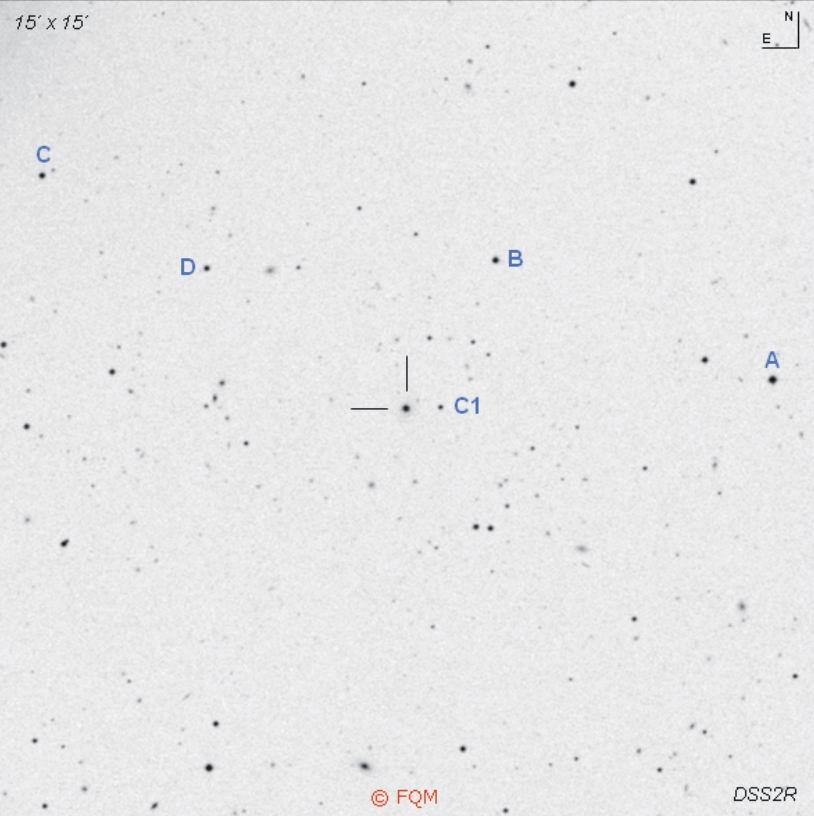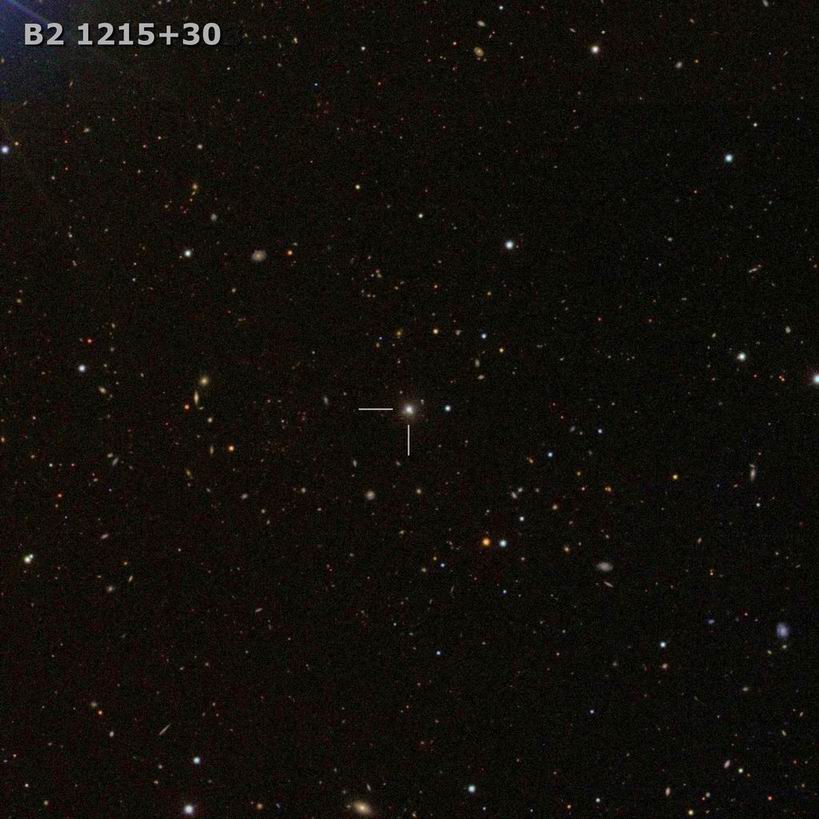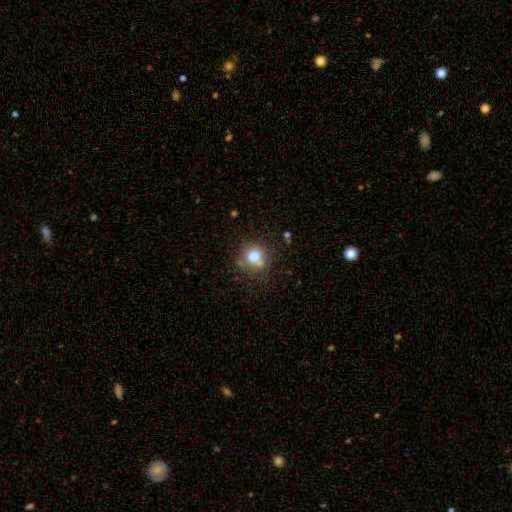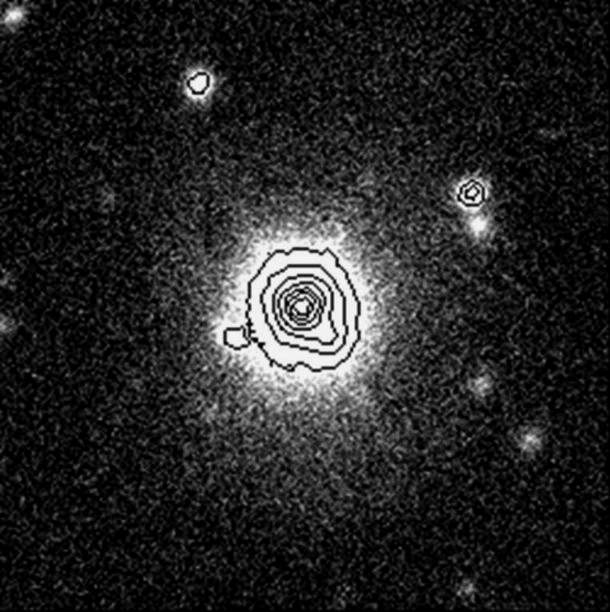
| Frankfurt Quasar Monitoring |
| B2 1215+30 (ON 325) |
| Cross-Identifications | ON+325, CSO 130, PKS 1215+303, S3 1215+30 TXS 1215+303, RGB J1217+301, QSO B1215+303 FBQS J1217+3007, 7C 1215+3023, 1215+303 1RXS J121752.1+300705, 1AXG J121752+3006 2E 1215.3+3023, 2MASS J12175207+3007007 SDSS J121752.08+300700.6, 1ES 1215+303 EXO 1215.3+3022, 1FGL J1217.7+3007 |
| Equat. coordinates | RA 12 17 52.0 DE +30 07 01 (J2000) |
| Constellation | Coma Berenices |
| Type | BL Lac |
| Redshift | z=0.130 (1,2) / z=0.237 (5) |
| Distance (3) |
523 Mpc (2) / 924 Mpc (6) |
| Total mag range (mv) (4) | 13.3 - 16.6 |
| Catalog Magnitude (1) | 15.62 |
| Absolute Magnitude | -23.4 MB (1) / --- MB (5) |
| Light Travel-Time | 1.604 × 109 yrs (2) / 3.015 × 109 yrs (6) |

Comparison stars
| star | B | V | Rc | Ic |
| A | 14.39 (0.02)1 | 13.70 (0.02)1 | --- | --- |
| B | 15.51 (0.02)1 | 14.95 (0.02)1 | 14.59 (0.04)2 | 14.21 (0.04)2 |
| C var |
15.66 (0.02)1 | 15.17 (0.02)1 | --- | --- |
| D | 16.71 (0.04)1 | 15.89 (0.04)1 | --- | --- |
| C1 | --- | 16.50 (0.14)2 | 16.21 (0.11)2 | 15.92 (0.15)2 |

 Credit: SDSS /
Size 3´× 3´ This
image shows the
host galaxy of B2 1215+30 with a bright star-like nucleus (app. diameter 15"×15") |  Credit: Nilsson et
al. (2003) / Size 47.4" × 47.4" This
R-band image by the Nordic Optical Telescope shows the elliptical host galaxy (image inverted) |

| B2
1215+30 = ON 325 is a variable BL Lac object in the northwestern part
of Coma Berenices, some 2.7° NW of 4.4-mag Gamma (14) CrB. The BL Lac object B2
1215+30 = ON 325 was discovered in 1965 as a radio
source during the Ohio State University radio survey (ON). The designation B2 1215+30
derives from the Bologna Radio Survey (B2),
where this object was also detected as a radio source in 1968. Later on, a one-sided radio
jet of 30 mas extension was detected. In 1971, a “slightly
non-stellar” object of
R=14.5 mag was
identified at
the position of the formerly detected radio source. The optical counterpart was
immediately classified as a quasi stellar object. Follow-up spectroscopy
revealed a featureless blue continuum with led to the classification as
a BL Lacertae-like object. As a “blue stellar object”,
B2 1215+30 was also detected by the Case University Survey (CSO) in the
late 1970s. Besides the
optical, infrared and radio, B2 1215+30 was also found to be an X-ray
emitter in 1988 by EXOSAT. Just
six years later, B2 1215+30 was detected as a gamma-ray source. The finding chart, as well as the high resolution images above, show the elliptical host galaxy of B2 1215+30 (ON 325) as a bright point source (centre), surrounded by a diffuse circular halo (apparent diameter 15"×15"; estimatet from POSS-II R-plate). The host galaxy has a physical diameter of about 66.0 × 57.5 kpc (based on SDSS images - assuming z=0.130). A faint companion galaxy, only a few arcsecs SW of the host, can be detected in the high resolution images above. All images are orientated North up and East to the left. A critical point regarding B2 1215+30 is its true distance. Of course we can rule out that B2 1215+30 is a high redshift object, as we can easily detect the blazar host. But in fact, there are two different redshift measurements which both confirm a relatively nearby object. The first redshift is z=0.130 (published in 1998), which is preferred by the NASA/IPAC Extragalactic Database. The second redshift, z=0.237, was published in the year 2000. This latter redshift, on the contrary, is preferred by the european CDS Strasbourg Database. Further spectroscopic investigations will tell about the true distance of this interesting object. As for most BL Lac objects, also B2 1215+30 shows fast and violent flux variations, ranging between 13 mag and 16 mag in the optical. CCD observers, as well as visual observers, shall use the comparison stars given above. Another sequence was published by Veron et al. (1975). Visual observers with telescopes of 10- to 12-inch of aperture will detect this blazar as a faint stellar object only during active state. During less active times, CCD observers are in the front row for photometric measurements. A notice to the photometrists: Do not use comparison star C. This star is an RR Lyrae-type variable with the designation HL Com (var. B=15.4-16.0). ____________
B2 1215+30 = ON 325 is located in the northwestern part of Coma
Berenices, some 2.7° NW of 4.4-mag Gamma (14) CrB. A 6.2-mag field star
(SAO 62943), only 11.6 arcmin NE of B2 1215+30, is a good check point to identify the
correct position of this BL Lac object. Starting our visual trip into the surrounding area we first take a look at the large open cluster Mel 111, also dubbed the "Coma Cluster", only about 280 light-years away. Mel 111 is an easy catch for the naked eye and binoculars, located in the close neighbourhood to B2 1215+30. B2 1215+30 is surrounded by a large number of bright galaxies. Deep sky showpieces like NGC 4559, NGC 4494 and NGC 4565, dubbed "The Neddle", are all close by. Right next to B2 1215+30, we find another interesting small galaxy group: Galaxy number one is NGC 4314, an 11.4-mag textbook face-on barred spiral with a very bright centre, only 1°E. Number two is 11.3-mag NGC 4274, another barred spiral with a peculiar ring-like central area, just 40 arcmin SE. Two other galaxies can be found only 1° SE of B2 1215+30: NGC 4278 is a bright 11.1-mag elliptical of type E1, which harbours an active nucleus of spectral-class S3. NGC 4278 has a fainter companion, NGC 4283, a 13.0-mag elliptical, only 3 arcmin NE of NGC 4278. The final member of this small group is NGC 4245, a 12.3-mag barred spiral of type SB0-a, just 30 arcmin S of B2 1215+30. All these galaxies are supposed to belong to the Coma I galaxy group. Those observers who like to hunt down some more very old quasi-stellar photons may turn to W Com, another violently variable BL Lac object, only 2° SE, at a distance of about 1.2×109 light-years.
Another large amplitude variable quasar, 4C 29.45, is located some 4° WSW of B2 1215+30 -
at a whopping distance of more than 6×109
light-years. |
| Akiyama, M., Ueda, Y., et al. 2003, ApJS, 148, 275; Optical Identification of the ASCA Medium Sensitivity Survey in the Northern Sky: Nature of Hard X-Ray-Selected Luminous Active Galactic Nuclei. Appenzeller, I., Thiering, I., Zickgraf, F.-J., et al. 1998, ApJS, 117, 319; Identification of a Complete Sample of Northern ROSAT All-Sky Survey X-Ray Sources. III. The Catalog. Bondi, M., Marchã, M.J.M., et al. 2004, MNRAS, 352, 112; VLBA polarization observations of BL Lac objects and passive elliptical galaxies. Browne, I.W.A. 1971, Nature, 231, 515; Two Bright New Quasi-stellar Radio Sources. Colla, G., Fanti, C., et al. 1970, A&AS, 1, 281; A catalogue of 3235 radio sources at 408 MHz. Craine, R.E.; A Handbook of Quasistellar and BL Lacertae Objects; Parchart Publishing House, Tuscon 1977. Fichtel, C.E., Bertsch, D.L., et al. 1994, ApJS, 94, 551; The first energetic gamma-ray experiment telescope (EGRET) source catalog. Fiorucci, M., Tosti, G. 1996, A&AS, 116, 403; VRI photometry of stars in the fields of 12 BL Lacertae objects. Giommi, P., Tagliaferri, G., Angelini, L. 1988, MmSAI, 59, 33; Serendipitous sources in EXOSAT images. Katajainen, S., Takalo, L.O., et al. 2000, A&AS, 143, 357; Tuorla quasar monitoring: I. Observations of 1995-1997. Kinman, T.D. 1976, ApJ, 205, 1; Photoelectric Magnitudes and Polarization Data for possible BL Lacertae Objects. Nilsson, K., Pursimo, T., et al. 2003, A&A, 400, 95; R-band imaging of the host galaxies of RGB BL Lacertae objects. Perlman, E.S., et al. 1998, AJ, 115, 1253; The Deep X-Ray Radio Blazar Survey. I. Methods and First Results. Pica, A.J., et al. 1988, AJ, 96, 1215; Long-term optical behavior of 144 compact extragalactic objects - 1969-1988. Sanduleak, N., Pesch, P. 1984, ApJS, 55, 517; The case low-dispersion northern sky survey. II Scheer, D.J., Kraus, J.D. 1967, AJ, 72, 536; A High-Sensivity Survey of the North Galactic Polar Region at 1415 MHz. Steinicke, W.; Katalog heller Quasare und BL Lacertae Objekte; Umkirch 1998. Véron, M.-P., Véron, P. 1973, A&A, 28, 319; Optical Positions of Radio Sources. II. Véron, P., Véron, M.-P. 1975, A&A, 39, 281; Photographic photometry of five BL Lacertae-type objects. Véron-Cetty, M.-P., Véron, P. 2001, A&A 374, 92; A Catalogue of Quasars and Active Nuclei: 10th edition. Véron-Cetty, M.-P., Véron, P. 2003, A&A 412, 399; A Catalogue of Quasars and Active Nuclei: 11th edition. Véron-Cetty, M.-P., Véron, P. 2006, A&A 455, 776; A Catalogue of Quasars and Active Nuclei: 12th edition. Véron-Cetty, M.-P., Véron, P. 2010, A&A 518, 10; A Catalogue of Quasars and Active Nuclei: 13th edition. Voges, W., Aschenbach, B., et al. 1999, A&A, 349, 389; The ROSAT all-sky survey bright source catalogue. White, R.L., et al. 2000, ApJS 126, 133; The FIRST Bright Quasar Survey. II. 60 Nights and 1200 Spectra Later. Wills, B.J., Wills, D., Douglas, J.N. 1973, AJ, 78, 521; Optical identifications of radio sources using accurate radio and optical positions. Wing, R.F. 1973, AJ, 78, 684; UBV sequences in the fields of radio sources. Wright, E.L. 2006, PASP, 118, 1711; A Cosmology Calculator for the World Wide Web. Zekl, H., Klare, G., Appenzeller, I. 1981, A&A 103, 342; Optical Brightness Variations of BL-Lacertae Objects. |
| Links: Landessternwarte Heidelberg Chara/PEGA Sloan Digital Sky Survey |
| home |